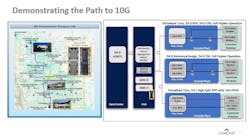Cablelabs 10G Showcase demos portend expanded DOCSIS 4.0 deployments
Charter Communications and Comcast led demos of DOCSIS 4.0 technology April 28 at the Cablelabs 10G Showcase that indicate such capabilities are nearing deployment readiness – and may be suitable for a wider variety of architecture scenarios than previously believed. In particular, Comcast’s discussion of Full Duplex DOCSIS (FDX) over a link with multiple prototype amplifiers indicates operators may not require full Node+0 to use this approach.
What was shown
Cablelabs hosted the 10G Showcase over multiple days, opening April 28 to the press to witness Comcast’s FDX demonstration, Charter’s workout of Extended Spectrum DOCSIS (ESD), and a look at Kyrio’s remote test management capabilities.
After a run-through of Kyrio’s FlexTest software platform and a move to the demo area, Charter kicked off the DOCSIS 4.0 demos with an ESD frequency-division duplex (FDD) implementation that combined 1.8-GHz amplifiers in a Node+4 cascade, a Generic Access Platform (GAP) prototype housing a Remote-MACPHY device node, and prototype DOCSIS 4.0 cable modems. (The GAP contained an integrated compute module from Intel; the module didn’t play a role into the demo other than to illustrate such integration possibilities.) Vecima Networks supplied the Remote MACPHY technology in the form of its Entra EN8400 Distributed Access Architecture (DAA) node with prototype silicon and Teleste contributed its ICON 3100/4300 1.8-GHz amplifiers. ATX Networks’ GigaXtend 2-GHz taps also played a supporting role.
With the connection set at 684 MHz upstream and 1794 MHz downstream, Charter showed the ability to support 8.9 Gbps downstream and 6.2 Gbps upstream using 4K QAM modulation. John Williams, vice president of engineering at Charter, said the service provider believes it can employ ESD in links with a greater number of amplifiers, but that Node+4 is typical in Charter’s network.
Comcast was next up with a multi-faceted demonstration of FDX that leveraged the company’s Harmonic-powered virtual CMTS core paired with a distributed access aggregation switch and a Remote-PHY device (RPD) DOCSIS 4.0 node linked together by 80 km of fiber (see figure above). The demonstration covered the delivery of high-speed broadband (approximately 8.5 Gbps downstream and 5 Gbps upstream) via 2K QAM. Rob Howald, Comcast Fellow and vice president of network architecture at Comcast (and speaker at the upcoming BTR Summit) said that 2K QAM is what Comcast uses currently but that 4K QAM capabilities will be coming in a few months. The demo network distributed capacity to a pair of DOCSIS 4.0 cable modems. Howald showed how the operator could quickly adjust the capacity distributed to each modem.
Another demo used the same vCMTS core with a DOCSIS 3.1 RPD (also from Harmonic) to support 10G PON via a five-port remote OLT module. Howald said Comcast was seeing around 7.6 Gbps symmetrically in such a setup.
Howald also showed off prototype FDX amplifiers capable of enabling FDX transmission in Node+2 architectures. He said that Comcast will release more details of this work in the second half of this year. However, Elad Nafshi, executive vice president and chief network officer at Comcast Cable, interjected that the company is targeting the ability to support Node+6.
DOCSIS 4.0 timing implications
The demos bode well for operators who want to upgrade their HFC architectures with DOCSIS 4.0 – if they’re willing to be a bit more patient for technology availability. Curtis Knittle, vice president of wired technologies at CableLabs, said the demos loosely represented the organization’s first DOCSIS 4.0 technology interop – although it is his expectation that more DOCSIS 4.0 technology will be ready for such exercises later this year.
The demonstrations also signaled that deploying DOCSIS 4.0 might be easier and more straightforward, particularly in terms of minimizing tap and amplifier relocation, than previously believed, Jeff Heynen, vice president and head of Dell’Oro Group’s Broadband Access and Home Networking market research program, wrote in a blog. However, he remains concerned about the pace of technology commercialization in the current constrained environment.
“The net result of both technology demonstrations is that any concerns around the value of upgrading to DOCSIS 4.0 relative to the cost are now taken off the table,” he wrote. “Instead, the question now shifts to one of timing. Operators around the world were firmly in the camp of one technology or the other, with all agreeing that some level of fiber would be a major part of any future network upgrade. Now, operators have two similarly performing technology options in front of them, each requiring upgrading of existing amplifiers, but with two very large questions around timing and availability of key components.”
About the Author

Stephen Hardy
Editorial Director & Associate Publisher
Stephen Hardy is editorial director and associate publisher of Lightwave and Broadband Technology Report, part of the Lighting & Technology Group at Endeavor Business Media. Stephen is responsible for establishing and executing editorial strategy across the both brands’ websites, email newsletters, events, and other information products. He has covered the fiber-optics space for more than 20 years, and communications and technology for more than 35 years. During his tenure, Lightwave has received awards from Folio: and the American Society of Business Press Editors (ASBPE) for editorial excellence. Prior to joining Lightwave in 1997, Stephen worked for Telecommunications magazine and the Journal of Electronic Defense.
Stephen has moderated panels at numerous events, including the Optica Executive Forum, ECOC, and SCTE Cable-Tec Expo. He also is program director for the Lightwave Innovation Reviews and the Diamond Technology Reviews.
He has written numerous articles in all aspects of optical communications and fiber-optic networks, including fiber to the home (FTTH), PON, optical components, DWDM, fiber cables, packet optical transport, optical transceivers, lasers, fiber optic testing, DOCSIS technology, and more.
